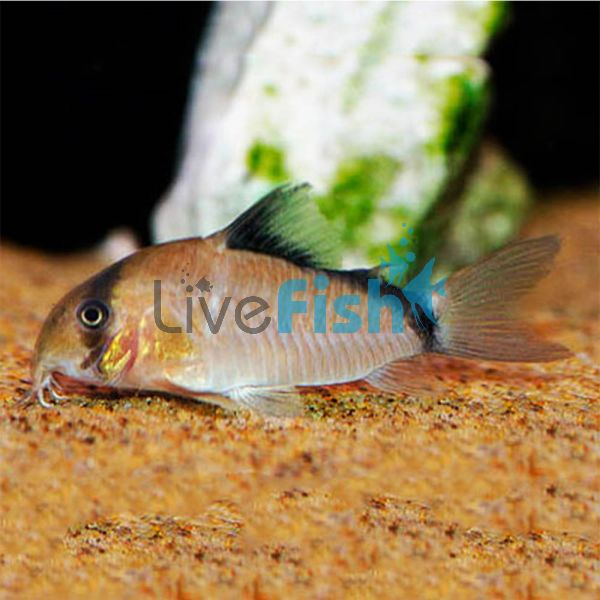Metae Corydoras 3cm
The Corydoras Metae has been a long-loved species in the family of corydoras for its lighter, contrasting colours compared to most species which are much darker. These adorable fish are often called bandit corydoras due to the dark stripes across their face which looks like a mask. This species is often one of the next upgrades in a corydoras keeper's journey which usually starts with the humble but drab bronze corydoras. Through the years of captive breeding, these fish have also become much cheaper. This species also stays at a small size of 5 cm which will make them a great species for a South American community display tank.
- Buy 4 for $25.02 each and save 10%
- Buy 8 for $23.63 each and save 15%
- Buy 12 for $22.24 each and save 20%
Metae Corydoras
The Corydoras Metae has been a long-loved species in the family of corydoras for its lighter, contrasting colours compared to most species which are much darker. These adorable fish are often called bandit corydoras due to the dark stripes across their face which looks like a mask. This species is often one of the next upgrades in a corydoras keeper's journey which usually starts with the humble but drab bronze corydoras. Through the years of captive breeding, these fish have also become much cheaper. This species also stays at a small size of 5 cm which will make them a great species for a South American community display tank.
Metae corydoras mostly have a black-and-white colour which is part of the reason they are so appealing. The stark contrast between the light and dark colours makes these fish stand out in the aquarium whereas most Corydoras species tend to just be dark. The body colour of the Metae corydoras is an off-white colour that tends to be more of a rusty or sandy colour near the face and transitions to white near the tail and belly. Near the mouth and cheek plate, they have a metallic green and gold sheen which looks stunning as it captures the light. The main point of contrast is the two eye stripes that give the bandit mask look along with the jet black dorsal stripe which starts from the dorsal fin and ends at the tail. Whether these fish are kept on a lighter or darker substrate, makes little difference due to how they stand out in either setting. Just like any other corydoras species, the Metae cories will constantly stir the substrate layer to look for food. This behavior ensures they are keeping the substrate turned over and any debris in the water column, which can then be picked up by the aquarium filter. They are almost exclusively bottom-dwelling fish and are an awesome option to add some life to the bottom of the tank.
The Metae are also considered to be schooling catfish and it would be best to keep them in a group of at least 5-6 although more than this will never hurt. Differentiating males and females is possible where the males are often smaller and narrower compared to the larger-bodied females. The best method to identify is to get a school and let a pair naturally form. Females are often triggered to spawn after being fed high-quality food and a slight reduction in the temperature. The wild origin of the Metae corydoras is South America and specifically the metae river.
Tank Recommendations for your Metae Corydoras
As Metae cories reach around 5 cm as adults it is best to keep them in an aquarium with a minimum size of around 70 liters. A larger aquarium will always be better since a larger school can be kept along with the space for other tank mates. A sand substrate is best as coarser substrates like gravel often result in corydoras damaging their barbels. They will also love plants in the aquarium and places for cover through the addition of driftwood. As these are tropical fish, it is best to maintain the temperature at around 24-26 degrees.
Suitable Tank Buddies
Metae corydoras are incredibly peaceful fish that can be kept in an massive range of community aquariums. They do not display any aggression even when breeding and make for a perfect addition even with sensitive or shy fish. The obvious consideration would be to just avoid keeping anything that might harm this fish.
Usually Compatible
Angelfish, cardinal tetras, rams, discus, and similar peaceful South American species.
Sometimes Compatible
Mystus catfish, convict cichlids, pearsi cichlids, and other peaceful territorial species.
Rarely Compatible
Large and aggressive species such as the Oscars may prey on the Corydoras. This is especially important as Corydoras have spines on their pectoral fins like many catfish, this can result in both the corydoras and the predator fish’s death.
Feeding your Metae Corydoras
Just like any other corydoras these fish are very easy to feed. They will take a wide range of pellets, flakes, and frozen foods. Just like any fish though they should be fed a varied diet with a mix of different foods. The ideal diet would be a good quality micro slow-sinking pellet or crushed flake, supplemented with frozen bloodworms or black worms or even live foods like baby brine shrimp or micro worms.
| Scientific Name | Corydoras Metae |
|---|---|
| Care Level | Moderate |
| Common Names | Metae Corydoras, bandit Corydoras, Meta River Corydoras |
| Diet | Carnivore |
| Fish Family | Callichthyidae |
| Lifespan (years) | 8 |
| Max. Length (cm) | 5 |
| Min. Tank Volume (l) | 70 |
| Origin | South America |
| Reef Safe | Yes |
| Sociability | Peaceful |
| Venomous | No |
| Water Conditions | 24-26° C, pH 6.0-7.0 |




